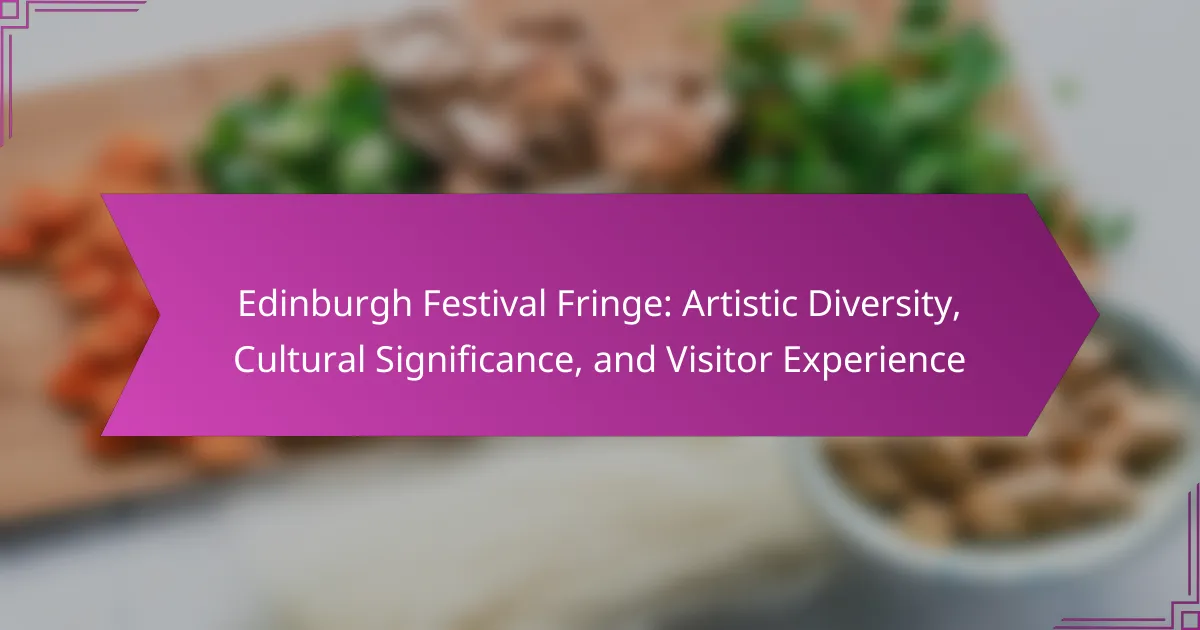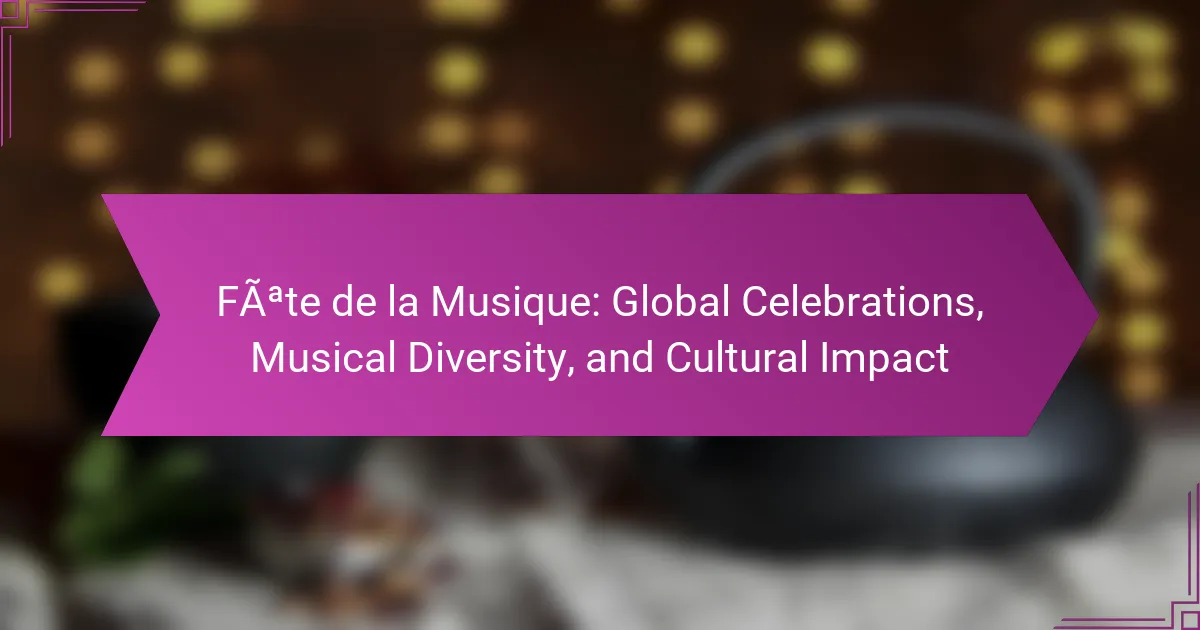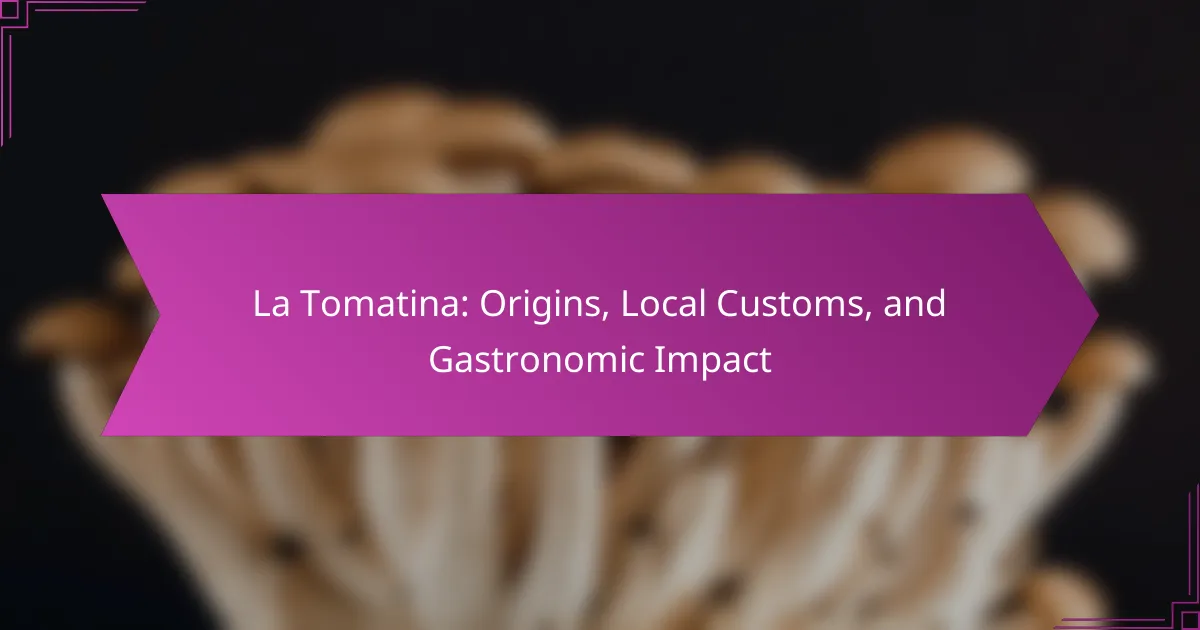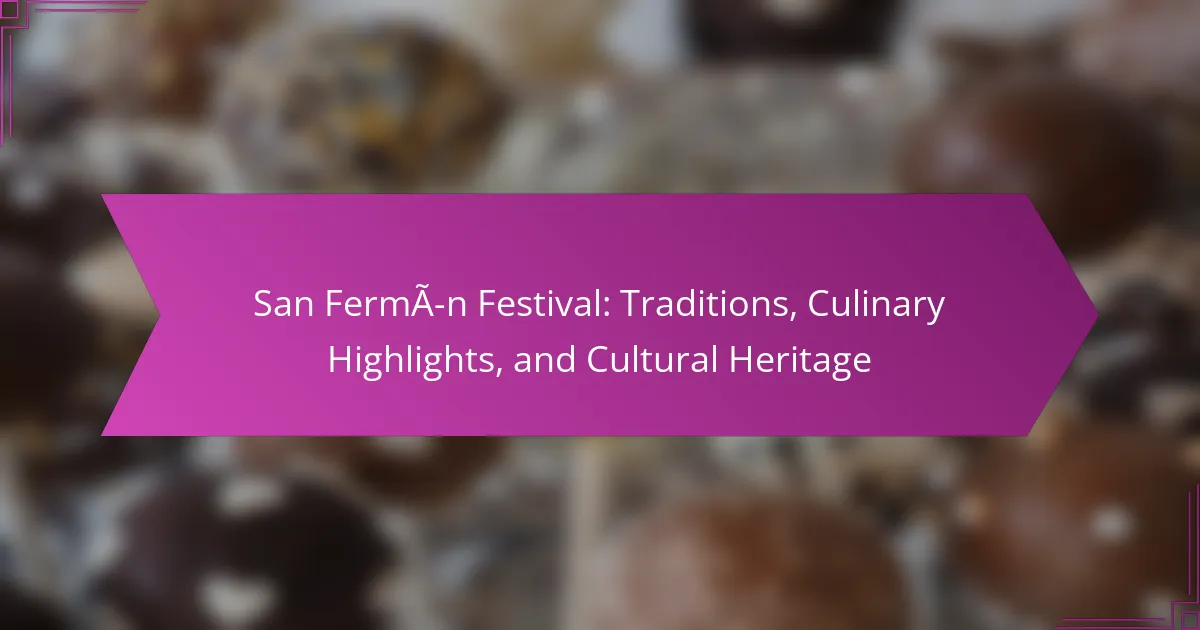Oktoberfest is a celebration of Bavarian culture that attracts millions each year. It features traditional music, diverse beer varieties, and festive foods like pretzels and sausages. The festival showcases Munich’s brewing heritage while promoting cultural exchange and community spirit. Recent trends include craft beers and sustainable practices, blending tradition with modernity.
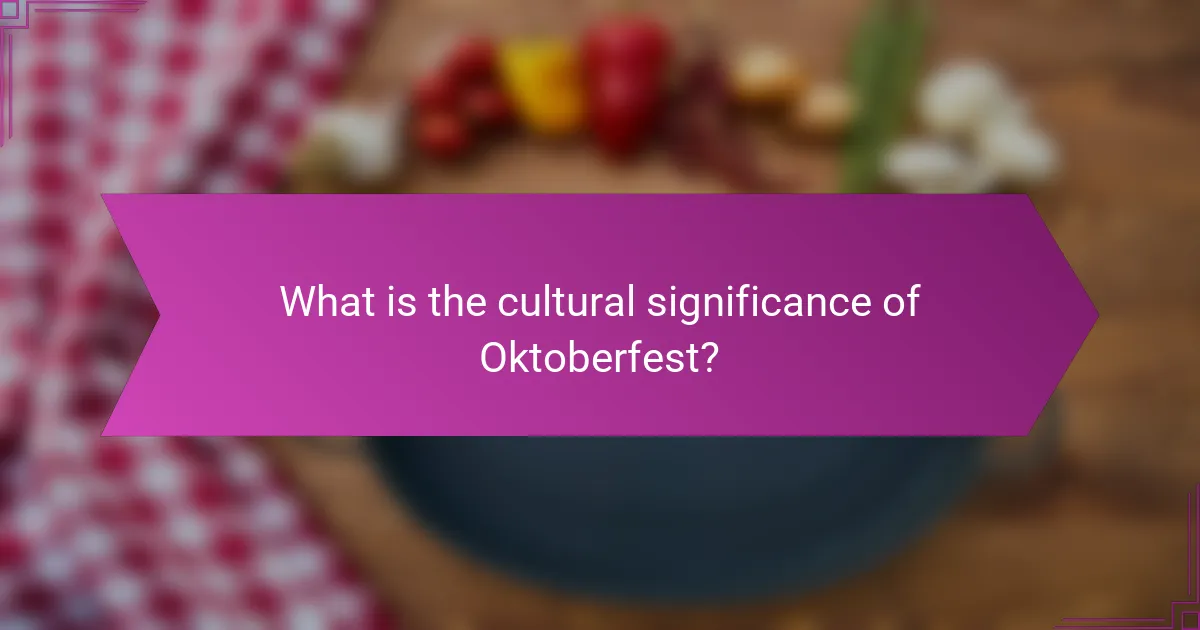
What is the cultural significance of Oktoberfest?
Oktoberfest holds significant cultural importance as a celebration of Bavarian traditions and community spirit. Originating in 1810 as a royal wedding festivity, it has evolved into the world’s largest folk festival. The event showcases traditional music, dances, and costumes, fostering a sense of unity among attendees.
The festival also highlights various beer varieties, primarily from Munich breweries, each with unique flavors and brewing techniques. This diversity in beer reflects the region’s rich brewing heritage. Festive foods, such as pretzels and sausages, complement the beer, enhancing the overall experience.
Oktoberfest attracts millions of visitors, making it a vital economic driver for the region. It promotes cultural exchange, drawing international tourists who engage with Bavarian customs. This blend of tradition and modernity exemplifies Oktoberfest’s enduring cultural significance.
How does Oktoberfest reflect German traditions and values?
Oktoberfest reflects German traditions and values through its celebration of community, craftsmanship, and culinary heritage. This festival showcases the importance of beer in German culture, highlighting various beer varieties like Märzen, which is traditionally served. Festive foods such as pretzels and sausages emphasize regional culinary practices, reinforcing the connection to local customs. The event promotes social interaction, unity, and pride, embodying the spirit of Bavarian hospitality and cultural identity. Each element of Oktoberfest serves as a reminder of Germany’s rich traditions and communal values.
Why is Oktoberfest celebrated globally?
Oktoberfest is celebrated globally to honor Bavarian culture and its beer heritage. The festival originated in Munich in 1810 and has since become a symbol of community and festivity. Cities worldwide host Oktoberfest events, showcasing traditional German beers, local brews, and festive foods like pretzels and sausages. These celebrations promote cultural exchange and foster connections among diverse communities. The unique atmosphere, marked by music and dance, enhances the experience, making it a cherished global tradition.
Which cultural events coincide with Oktoberfest?
Oktoberfest coincides with various cultural events, enhancing its festive atmosphere. Notable events include the Munich Oktoberfest, the German Unity Day, and local harvest festivals. These events celebrate German heritage, showcasing traditional music, dance, and cuisine. The unique blend of beer varieties at Oktoberfest complements these cultural festivities, with over 14 different types of beer served. Each event contributes to the rich tapestry of Bavarian culture, attracting millions of visitors annually.
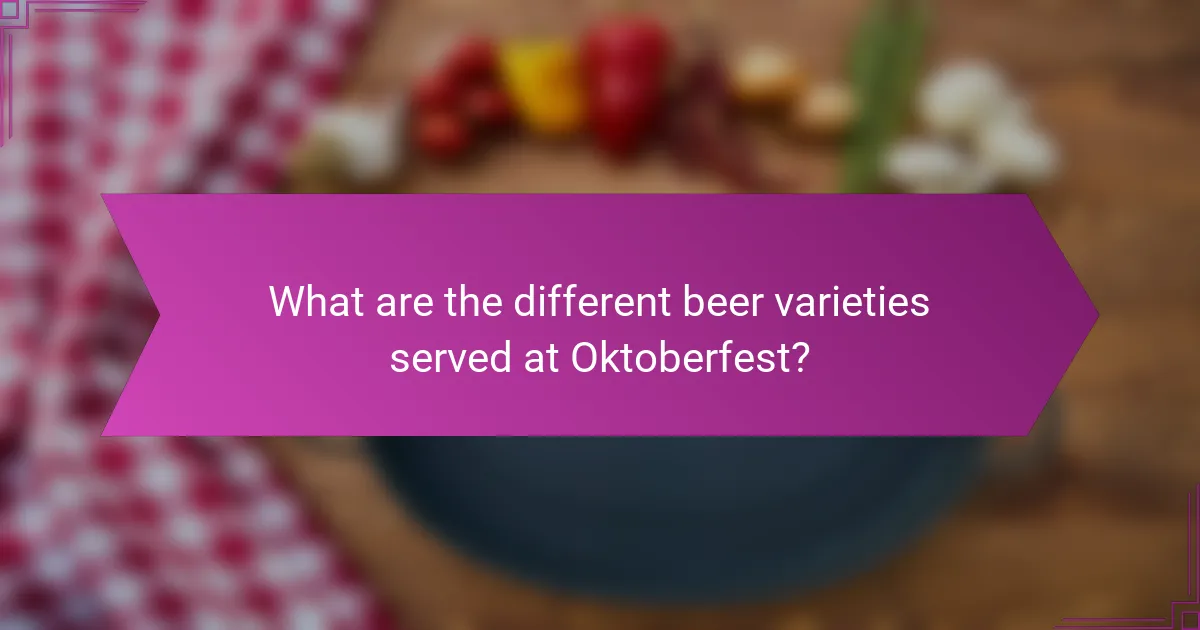
What are the different beer varieties served at Oktoberfest?
Oktoberfest features a variety of beer styles, primarily Märzen, which is a traditional amber lager. Other varieties include Hefeweizen, a wheat beer, and Dunkel, a dark lager. Each beer reflects the rich brewing heritage of Bavaria and contributes to the festival’s cultural significance. The festival emphasizes quality, with all beers served conforming to the Reinheitsgebot, the German Beer Purity Law.
How do the beer styles vary by brewery?
Beer styles vary significantly by brewery, reflecting local traditions and brewing techniques. Each brewery often emphasizes distinct flavors, ingredients, and brewing methods that contribute to unique Oktoberfest beers.
For instance, traditional German breweries typically produce Märzen, a rich, malty lager with a moderate hop bitterness. In contrast, craft breweries may introduce innovative twists, such as using local ingredients or experimental hops, resulting in a diverse range of Oktoberfest styles.
The cultural significance of Oktoberfest also influences these variations, as breweries aim to capture the essence of the festival while appealing to modern tastes. This results in both classic and contemporary interpretations of Oktoberfest beer, showcasing the creativity and diversity within the brewing community.
What are the alcohol content differences among Oktoberfest beers?
Oktoberfest beers typically have an alcohol content ranging from 5.5% to 6.0%. The variations depend on the specific style and brewing process. Märzen-style beers, which are traditional for Oktoberfest, generally fall within this range, providing a balanced flavor profile. Some craft interpretations may exceed this range slightly, showcasing unique brewing techniques.
Which seasonal and regional beers are featured at Oktoberfest?
Oktoberfest features a variety of seasonal and regional beers, primarily Märzen, a traditional Bavarian lager. Other styles include Hefeweizen, Dunkel, and Bock, showcasing the rich brewing heritage of Germany. These beers typically have a malty flavor profile and are brewed to commemorate the festival’s origins.

What festive foods are traditionally served at Oktoberfest?
Traditional foods served at Oktoberfest include pretzels, sausages, roast chicken, pork knuckles, and potato salad. These dishes reflect Bavarian culinary heritage and enhance the festive atmosphere.
Pretzels are iconic, often enjoyed with mustard. Sausages, such as bratwurst and weisswurst, are staples. Roast chicken, seasoned and crispy, is a popular choice among festival-goers. Pork knuckles, or Schweinshaxe, offer a hearty option. Lastly, potato salad complements the meal, often served warm or with a vinegar dressing.
How do traditional dishes enhance the Oktoberfest experience?
Traditional dishes significantly enhance the Oktoberfest experience by offering authentic flavors and cultural connections. These foods, such as pretzels, sausages, and roasted meats, create a festive atmosphere that complements the beer varieties served. The enjoyment of traditional Bavarian cuisine fosters social interactions among attendees, enriching the overall celebration. Unique dishes like Schweinshaxe (pork knuckle) and regional specialties highlight the culinary heritage of Bavaria, making Oktoberfest a comprehensive cultural event.
What are the most popular food pairings with Oktoberfest beers?
Oktoberfest beers pair well with traditional German foods. Popular pairings include pretzels, sausages, roast chicken, and potato salad. These foods enhance the beer’s malty flavors and complement its crispness. Additionally, cheese platters with aged varieties provide a delightful contrast to the beer’s bitterness.
Which unique or rare dishes are found at Oktoberfest?
Oktoberfest features unique dishes such as Hendl, Obatzda, and Schweinshaxe. These dishes reflect Bavarian culinary traditions and enhance the festival experience.
Hendl, or roast chicken, is seasoned and served with crispy skin. Obatzda is a cheese spread made from Camembert, butter, and spices, often enjoyed with pretzels. Schweinshaxe, or pork knuckle, is a hearty dish with crispy skin and tender meat, typically served with sauerkraut and dumplings.
Other rare offerings include Käsespätzle, a cheesy noodle dish, and various regional specialties like Leberkäse, a type of meatloaf. These unique dishes contribute to the cultural significance of Oktoberfest, showcasing Bavaria’s rich culinary heritage.
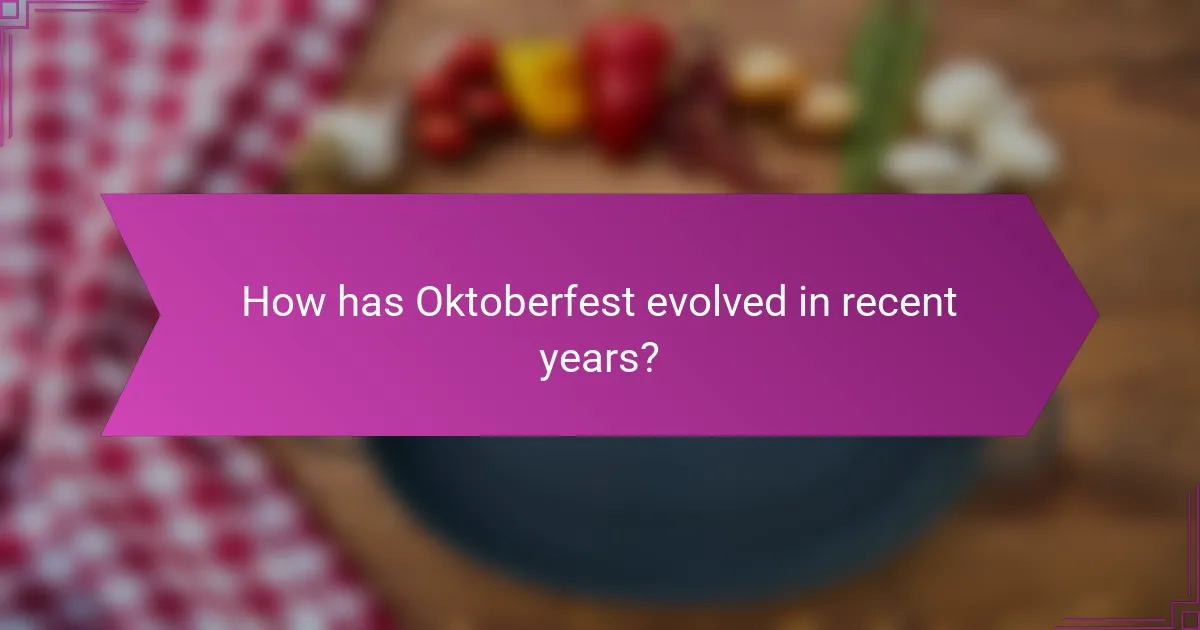
How has Oktoberfest evolved in recent years?
Oktoberfest has transformed significantly, embracing modern trends while preserving tradition. Recent years have seen an increase in craft beer varieties, catering to diverse tastes. The festival has expanded its culinary offerings, featuring international foods alongside traditional German dishes. Additionally, Oktoberfest has incorporated sustainability initiatives, such as eco-friendly practices and local sourcing. These changes reflect a balance between honoring heritage and adapting to contemporary preferences.
What modern influences shape the festival today?
Modern influences shaping Oktoberfest include globalization, evolving consumer preferences, and social media engagement. Globalization has introduced diverse beer varieties and international cuisines, enhancing the festival’s appeal. Consumer preferences now favor craft beers and unique flavors, prompting breweries to innovate. Social media platforms amplify Oktoberfest’s reach, allowing for real-time sharing of experiences and promoting the festival worldwide. These factors contribute to Oktoberfest’s dynamic cultural significance while maintaining its traditional roots.
How do sustainability practices impact Oktoberfest?
Sustainability practices positively impact Oktoberfest by reducing waste, promoting local sourcing, and enhancing community engagement. These initiatives contribute to environmental preservation and cultural integrity. For example, Oktoberfest organizers implement recycling programs, use biodegradable materials, and support local breweries. As a result, the festival fosters a more responsible celebration of Bavarian culture while minimizing its ecological footprint.
What role does technology play in the contemporary celebration?
Technology enhances the contemporary celebration of Oktoberfest through digital engagement and logistics. Mobile apps provide festival maps, schedules, and beer menus, improving visitor experience. Social media platforms amplify event visibility, connecting attendees globally. Additionally, cashless payment systems streamline transactions, enhancing efficiency. Virtual reality experiences offer immersive previews of the festival, appealing to tech-savvy audiences. Drones capture aerial views, showcasing the festival’s grandeur. These innovations reflect Oktoberfest’s adaptation to modern trends while preserving its cultural significance.

What tips can enhance the Oktoberfest experience for attendees?
To enhance the Oktoberfest experience, attendees should focus on planning, participation, and exploration. Arrive early to secure a good spot, as tents fill quickly. Try various beer varieties, including local and seasonal brews, to appreciate the festival’s cultural significance. Engage in traditional activities like polka dancing and enjoy festive foods such as pretzels and sausages. Lastly, explore the surrounding attractions to fully immerse in Bavarian culture.
How to navigate the festival layout effectively?
To navigate the Oktoberfest layout effectively, familiarize yourself with key areas like beer tents, food stalls, and entertainment zones. Start at the main entrance, where maps are available. Prioritize visiting popular tents early to secure seating.
1. Obtain a festival map at the entrance.
2. Identify major beer tents and their specialties.
3. Plan your route to include food stalls with local delicacies.
4. Allocate time for entertainment events and live music.
5. Stay aware of festival timings and peak crowd hours.
What are the best practices for enjoying food and beer at Oktoberfest?
To enjoy food and beer at Oktoberfest, prioritize local dishes and traditional brews. Pairing regional specialties like pretzels and sausages with beer enhances the experience. Opt for lighter beers with rich foods and savor each sip to appreciate the unique flavors. Embrace the festive atmosphere by sharing meals and drinks with friends.
How to prepare for attending Oktoberfest as a first-timer?
To prepare for attending Oktoberfest as a first-timer, focus on planning, attire, and cultural understanding. Start by researching the festival’s schedule and events to maximize your experience. Dress in traditional Bavarian clothing, such as lederhosen or dirndls, to immerse yourself in the culture. Familiarize yourself with various beer varieties offered, including Märzen and Hefeweizen, and explore popular festive foods like pretzels and sausages. Lastly, understand the etiquette, such as toasting customs, to engage respectfully with locals and fellow attendees.
